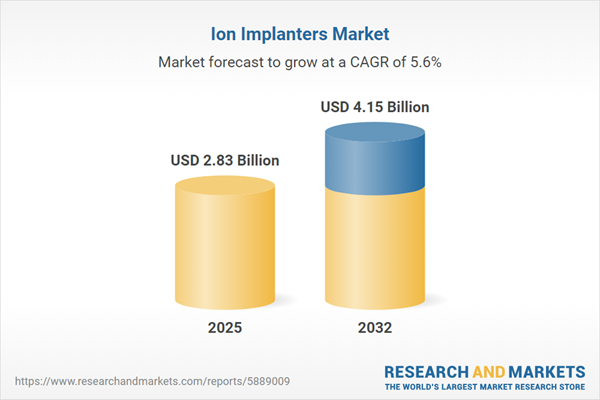Speak directly to the analyst to clarify any post sales queries you may have.
The ion implanters market is adapting fast as semiconductor technology advances, demanding new strategies and operational frameworks from industry leaders. Stakeholders are looking to future-proof their positions as new standards and capabilities shape the competitive environment.
Market Snapshot: Ion Implanters Market Size & Growth
The global ion implanters market reached USD 2.68 billion in 2024 and is set to grow to USD 2.83 billion by 2025, with projections of USD 4.15 billion by 2032. This expansion reflects a compound annual growth rate (CAGR) of 5.60%. Primary drivers include the rising adoption of advanced ion implantation processes, which are essential for high-standard semiconductor manufacturing. Sector growth is further stimulated by escalating demand in consumer electronics and automotive applications, alongside more stringent manufacturing requirements. In response, industry players are diversifying their offerings and adopting next-generation implanter systems to secure long-term relevance as technological advances and new market forces reshape the landscape.
Scope & Segmentation of the Ion Implanters Market
This report delivers segmented insights to support executive decisions across investment, procurement, and market entry planning:
- Wafer Size: Encompasses traditional 200mm-and-below and advanced 300mm wafers, enabling legacy plant updates and development of modern fabrication facilities alike.
- Doping Process: Covers both N Type and P Type methods, underpinning compatibility with evolving device architectures in semiconductor manufacturing.
- End User: Profiles pure play foundries, integrated device manufacturers, and OSAT providers, delineating how procurement cycles and end-user demands influence the market and broader value chain.
- Implanter Type: Evaluates high current, medium current, and high energy systems, aligning technology selection with chip production throughput and technical objectives.
- Application Scope: Explores use in logic circuits, memory segments (including DRAM and NAND Flash), and power semiconductors, identifying focal points for differentiation and strategic positioning.
- Region: Considers key regions such as the Americas, Europe, Middle East & Africa, and Asia-Pacific, emphasizing mature and emerging markets for tailored expansion and risk mitigation.
- Key Companies: Features competitive benchmarking for Applied Materials, Axcelis Technologies, Sumitomo Heavy Industries, Nissin Ion Equipment, and CoorsTek, helping leaders understand current market structures and partnership avenues.
Key Takeaways for Senior Decision-Makers
- Deployment of next-generation ion implanters is creating greater agility in semiconductor manufacturing, allowing organizations to adapt to fast-changing design and process requirements.
- Investment in automation and real-time monitoring delivers consistent quality control and supports responsive global supply chain management, driving operational resilience.
- Flexibility in system design for multiple wafer sizes and product applications positions manufacturers to manage shifting industry cycles and extend the usefulness of capital investments.
- Commitment to energy efficiency and compliance with evolving standards offers a competitive edge while aligning equipment renewal strategies with global regulatory trends.
- Early compliance with diverse regulatory environments aids in reducing technology adoption delays and minimizing exposure to operational risks across key semiconductor markets.
Tariff Impact on Equipment Supply Chains
Recent tariff adjustments, particularly in the United States, have prompted ion implanter equipment suppliers to revise their sourcing and distribution models. Companies are putting greater focus on sourcing local content, building regional alliances, and utilizing leasing along with refurbishment options. These measures enhance responsiveness and strengthen resilience, ensuring organizations can better manage fluctuations and uncertainties in international trade environments.
Methodology & Data Sources
This analysis combines primary interviews with leaders and technical experts in semiconductor manufacturing with a comprehensive review of leading industry publications. Ongoing benchmarking and careful monitoring of market developments underpin the report, ensuring decision-makers receive balanced, current insights to inform high-stakes planning.
Why This Ion Implanters Market Report Matters
- This report offers clear direction for executive teams to align investments, R&D, and innovation programs with both near-term opportunities and the broader semiconductor equipment environment.
- Procurement and supply chain strategists gain practical segmentation and up-to-date context, enabling more effective sourcing strategies and partnerships across the global semiconductor market.
- Portfolio and development leaders can use these insights to foster strategic alliances, refine capital deployment, and build competitive strength in the ion implanters sector.
Conclusion
By leveraging this report, senior leaders can anticipate change, reinforce competitive positioning, and allocate resources with greater confidence as the semiconductor market continues to advance.
Additional Product Information:
- Purchase of this report includes 1 year online access with quarterly updates.
- This report can be updated on request. Please contact our Customer Experience team using the Ask a Question widget on our website.
Table of Contents
3. Executive Summary
4. Market Overview
7. Cumulative Impact of Artificial Intelligence 2025
Companies Mentioned
The companies profiled in this Ion Implanters market report include:- Applied Materials, Inc.
- Axcelis Technologies, Inc.
- Sumitomo Heavy Industries, Ltd.
- Nissin Ion Equipment Co., Ltd.
- CoorsTek, Inc
Table Information
| Report Attribute | Details |
|---|---|
| No. of Pages | 187 |
| Published | November 2025 |
| Forecast Period | 2025 - 2032 |
| Estimated Market Value ( USD | $ 2.83 Billion |
| Forecasted Market Value ( USD | $ 4.15 Billion |
| Compound Annual Growth Rate | 5.6% |
| Regions Covered | Global |
| No. of Companies Mentioned | 6 |









